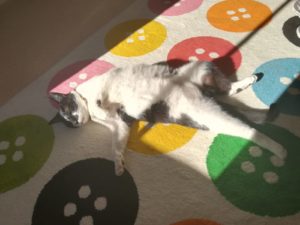 With this HEATWAVE we are out enjoying ourselves with family, friends and our pets. Our four legged friends can love the sun but over-heating can lead to serious problems and the HEAT is set to continue for at least another week! So, we thought it would be helpful to provide some safety advice in these high temperatures.
With this HEATWAVE we are out enjoying ourselves with family, friends and our pets. Our four legged friends can love the sun but over-heating can lead to serious problems and the HEAT is set to continue for at least another week! So, we thought it would be helpful to provide some safety advice in these high temperatures.
All animals can suffer but mostly we think about dogs who would usually go out and do the same activities as us. This can be particularly the case for large breed dogs, overweight dogs and those with thick dense coats. Bracycephalic breeds such as pugs and bull dogs can also present with respiratory difficulties in these hot temperatures.
Simple tips for managing dogs in the heat are:
Avoid walking in the heat of the day; not only will walking in the extreme heat lead to over-heating, the hot ground can be painful for your pets to walk across. The best times are first thing in the morning or last thing at night. These times can still be fairly hot and humid so limit their length and level of activity too.
Get your dogs coat clipped short to reduce added weight and excess insulation.
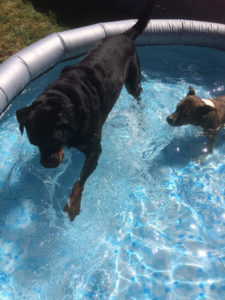 Keeping your dog cool; dogs only have sweat glands in their pads so this is the only place they can only lose heat via sweating. Dogs will also pant harder to lose excess heat but there is a limit to this too. To try and help cool your dog down the best method is to wet their coat with luke-warm water and apply a fan. A dog friendly paddling pool can also be a good idea. Cool mats and cooling coats can be effective too as long as they are kept wet.
Keeping your dog cool; dogs only have sweat glands in their pads so this is the only place they can only lose heat via sweating. Dogs will also pant harder to lose excess heat but there is a limit to this too. To try and help cool your dog down the best method is to wet their coat with luke-warm water and apply a fan. A dog friendly paddling pool can also be a good idea. Cool mats and cooling coats can be effective too as long as they are kept wet.
Please, do not, under any circumstance, leave your pet in a hot car. Leaving the window down is not adequate.
If you have a white or pale coated pet their extremities (ear tips and muzzle) can be prone to sunburn. Dog friendly sun creams are available and are advisable if your pet is at risk.
Why and how may a bracycephalic breed be affected?
Bracycephalic breeds can have excessive soft tissue at the back of their mouths and throat This is because their skulls are compacted but they still have the same level of soft tissue present, they can also suffer from an overlong soft palate and eversion of laryngeal saccules. All of this can restrict airflow resulting in noisy breathing and increased breathing effort.
In hot weather these tissues can become slightly larger; this is due to excessive panting to lose heat. The increase in airflow and subsequent soft tissue vibrations cause soft tissue inflammation and swelling. The more the tissues swell the smaller the area for airflow becomes thus they need to work harder to breathe and this exacerbates the swelling further. As you can see a vicious cycle can be entered. Ultimately airway obstruction can occur, often referred to as an obstructive crisis.
It is important that these breeds really are kept as cool and calm as possible by following the above advice. If your pet is struggling with their breathing and you are concerned please contact us. Animals showing signs (severe breathing difficulties, collapse, blue gums) of an obstructive crisis require immediate veterinary attention.
What about rabbits and cats?
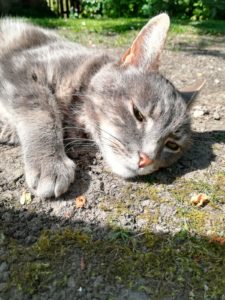 Cats: due to their roaming nature it can be difficult to control the environment a cat is in however providing accessible places for them to keep cool will help, including shelter and shade. Apply sun cream to pale ear tips especially in white cats. Remember to keep water out and topped up for them, this might not be a routine we are used to as many of our feline friends drink outside only!
Cats: due to their roaming nature it can be difficult to control the environment a cat is in however providing accessible places for them to keep cool will help, including shelter and shade. Apply sun cream to pale ear tips especially in white cats. Remember to keep water out and topped up for them, this might not be a routine we are used to as many of our feline friends drink outside only!
Rabbits and guinea pigs: do no put small furries out in the direct light and heat of the day. Avoid this by providing shade, shelter and placing a damp towel over part of their run or hutch. Placing a cold tile in their shaded spot can provide an extra cool surface for them to lay on or put in a bottle of frozen water for them to lay against.
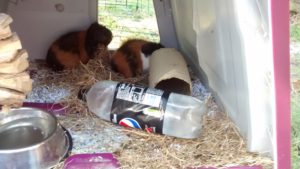
If your rabbit is struggling in the heat then misting water on their ears can help to cool them down. You can also position a fan to provide a breeze but care for this not to blow directly on them.
This weather is also high risk for fly strike; make sure hutches are extra clean and check your rabbit and guinea pigs daily to ensure their bottoms are clean. Soiled back ends and dirty bedding will attract unwanted flies.
What is Heat Stroke?
There are a number of heat associated conditions progressing from simple over-heating, to heat cramp or heat exhaustion and more critically, heat stroke. Animals can adapt to a gradual increase in temperature but during sudden heatwaves or sudden temperature rises, for example being trapped in a hot car they can suffer from non-exertional heat stroke. This condition is serious as the high body temperatures result in a systemic inflammatory response which can result quickly in multiple organ failure. If your pet is showing signs of illness after being in the heat then please seek veterinary advice.
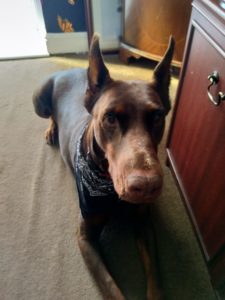 Duchess is a beautiful Doberman Pinscher who deserves Hollybank’s ‘brave pet’ recognition as she did something not only brave but ultimately life saving for her owners recently.
Duchess is a beautiful Doberman Pinscher who deserves Hollybank’s ‘brave pet’ recognition as she did something not only brave but ultimately life saving for her owners recently.







